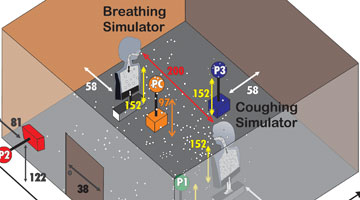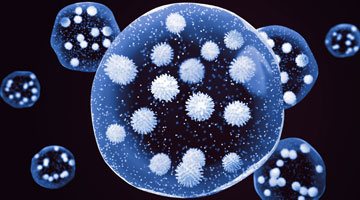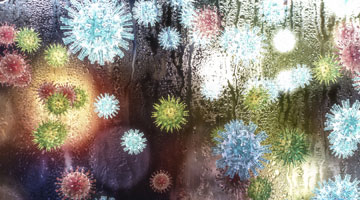"40-60% r.F. ist die ideale Luftfeuchtigkeit in Innenräumen. Bei diesem Wert wird das luftgetragene Grippevirus schnell inaktiviert und die Luftfeuchtigkeit liegt unter dem Wert, der das Wachstum von Schimmelpilzen fördert. "
Dr. med. Walter Hugentobler

Luftfeuchtigkeit bekämpft die Grippe
Eine Luftfeuchtigkeit in Innenräumen zwischen 40 und 60% r.F. ist wissenschaftlich erwiesenermassen geeignet, um luftübertragene Grippeinfektionen zu bekämpfen. Dieses ideale Feuchtigkeitsniveau verkürzt die Zeit, in der die luftübertragene Grippe ansteckend bleibt.
Die folgenden wissenschaftlichen Studien sind nur einige von vielen, die zeigen, wie lebenswichtig die richtige Luftfeuchtigkeit in Innenräumen für die Bekämpfung von Infektionen aus der Luft ist.
In den kalten Wintermonaten, wenn die Heizsysteme die Luft austrocknen, fällt die Luftfeuchtigkeit in Innenräumen oft in den trockenen Gefahrenbereich von weniger als 40 % r.F. Dies führt zu mehr Grippe und Atemwegsinfektionen, die sich in der Raumluft, die wir alle teilen, ausbreiten.
Die Verwendung von Luftbefeuchtern ist nur eine Möglichkeit, um sicherzustellen, dass die ideale Luftfeuchtigkeit in Innenräumen den ganzen Winter über aufrechterhalten wird.

Was uns wissenschaftliche Studien darüber lehren :
Noti et al 20131
Manikin experiment

Method: Manikins “coughed” flu from nebulizers into a room at different humidity levels. Air samplers collected aerosol particles to assess their continued infectious nature.
Summary result: Flu retains its infectious nature in dry air below 40%RH up to five times longer than in air above 40%RH.
Yang et al 20122
Droplet observation

Method: Measured the survival of flu in droplets of different solutions at varying humidity levels to isolate the effects of humidity and the host droplet’s composition on flu.
Summary result: At room temperature, flu survival rate is lowest at around 50%RH, due to salt concentrations of the host droplet being most damaging to the virus at this level.
Lowen et al 20073
Guinea pig experiment

Method: Placed caged guinea pigs infected with flu next to uninfected caged guinea pigs, in a controlled environment at different humidity levels to assess humidity’s effect on transmission.
Summary result: Flu transmission between guinea pigs was lowest at 50%RH and significantly increased as the humidity decreased.
Studien zu Absentismus
Sale 19724
Nursery study

Method: Winter absenteeism from respiratory infections was recorded across two nurseries without humidification (ave. 35-40%RH) and compared to one nursery with humidification (ave. 50%RH).
Summary result: Child absenteeism from respiratory infections was 7.1% in the group without humidification and 1.3% in the group with humidification.
Gelperin 19735
Army study

Method: Incidents of respiratory infection in two groups of army recruits was monitored in two barracks; one with humidification (ave. 40%RH±5%) and one without humidification (ave. 20%RH±8%).
Summary result: Incidents of respiratory infections across two winters and 1,560 recruits was 14% lower in the humidified barracks than the non-humidified barracks.
Green 19816
Hospital study

Method: Staff absenteeism was monitored across three hospitals during subsequent winters. Two hospitals had no humidity control (ave. 19-22%RH) and one had humidification (ave. 31-34%RH).
Summary result: The average absenteeism rate in the non-humidified hospitals was 2.5%. In the humidified hospital this was reduced to 1.87% in one year and 1.56% the following year.
Sie könnten auch an folgendem interessiert sein ...
Wenn die Luftfeuchtigkeit an meinem Arbeitsplatz zu niedrig ist. Was sollte ich da machen?
Wenn die Luftfeuchtigkeit an Ihrem Arbeitsplatz ständig unter 40 % r.F. liegt, kann dies Ihre Gesundheit beeinträchtigen. Hier erfahren Sie, was Sie ...
Mehr erfahrenReferences:
2 – Yang et al 2012, Relationship between Humidity and Influenza A Viability in Droplets and Implications for Influenza’s Seasonality, PLoS ONE 7(10): e46789
3 – Lowen et al, 2007, Influenza virus transmission is dependent on relative humidity and temperature, PLoS One Pathogens Okt. 2007/Vol. 3/Issue 10/e151
4 – Sale, 1972, Humidification to reduce respiratory illnesses in nursery school children, Southern Medical Journal, July 1972, Vol. 65, No 7
5 – Gelperin, 1973, Humidification and Upper Respiratory Infection Incidence, Heating, Piping and Air Conditioning, Vol. 45, No.3
6 – Green, 1981, Winter humidities and related absenteeism in Canadian hospitals, Digest of the 3rd CMBFS Canadian Clinical Engineering Conference

